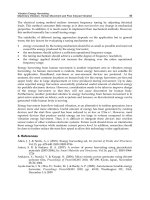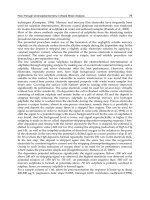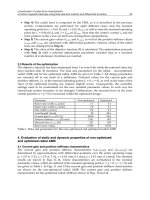Preservation of fruit and vegetables - Part 4 doc
Bạn đang xem bản rút gọn của tài liệu. Xem và tải ngay bản đầy đủ của tài liệu tại đây (293.14 KB, 36 trang )
Jam and juice making, syrups, jellies and candied fruit 51
7 Jam and juice making, syrups,
jellies and candied fruit
There are several possible methods of preserving fruit. Canning, steril-
izing and drying have already been dealt with in the preceding chap-
ters. This chapter discusses the possibilities of making juice, jams,
jellies and candied fruit. This can be done with all kinds of fruit. A
mixture of two or more kinds of fruit often gives a better, more
rounded taste in the final product. Apricots and peaches combine very
well with orange or grapefruit juice. Orange and grapefruit juices can
also be mixed. Pineapple is often mixed with orange, grapefruit, or
apricot juice. The juices are best mixed before preserving, not just
before use. Choose the proportion of the fruit in the mixtures accord-
ing to your individual taste. The proportions have no effect on the
shelf-life of the product. The methods described in this chapter are
based on preserving with sugar or heat or a combination of these two.
It is best to start with fresh, undamaged fruit that is not overripe.
Mouldy fruit increases the chance of spoilage and of causing food
poisoning. Overripe fruit results in a tasteless or sometimes slightly
musty-tasting product. All materials with which the fruit comes into
contact, such as knives, pots, kettles, cans, pans and bottles, should be
made of stainless steel, glass, undamaged enamel or good-quality
plastic. Avoid using aluminium or galvanized tools and kettles, as the
acid in the fruit will attack these. The acid can dissolve the aluminium
and the zinc layer of the galvanized materials, resulting in a metallic
taste and possible zinc poisoning.
This chapter first describes drink preparation, followed by methods for
the preparation of other fruit products such as jelly, candied fruit, jam
and chutney.
Preservation of fruit and vegetables 52
7.1 Making fruit juices
This section gives an overview of fruit juice preparation, followed by
a description of different types of packing, bottling methods and stor-
age of the bottled product. Examples are also given of the preservation
of tomato juice and the preparation of fruit juice concentrates.
Juice extraction
Preserved fruit juices keep their fresh taste and attractive colour as
long as they are not heated for too long or at too high a temperature.
Prolonged boiling or heating changes the taste, except with tomato
and apricot juice.
Appendix 6 lists methods for the preparation and juice extraction of
several types of fruit. Be sure not to heat the juice any longer than is
indicated.
The extraction of fruit juice can be done in three ways. It is important
to work as quickly as possible and to expose the juice as little as pos-
sible to the open air. Heating the fruit aids juice extraction and gives
the juice a deeper colour. Heating also inactivates the enzymes and
increases the shelf-life of the juice. The table below shows which
fruits should or should not be heated before extraction.
Table 2: Heating or not heating before extraction
Heat before extraction Do not heat before extraction
Apricots Rhubarb Apples
Berries Tomatoes Morello (sour) cherries
Red cherries Plums Green grapes
Peaches Purple grapes Citrus fruit
Mango
Method 1
Clean the fruit and cut it into pieces. Heat the fruit with very little
water until sufficient liquid has been extracted. Turn the mass onto a
wet muslin cloth, put this into a sieve, and let the juice drip without
Jam and juice making, syrups, jellies and candied fruit 53
pressing or stirring. This gives a clear juice. More juice is obtained
with squeezing, but this will make the juice cloudy.
Method 2
This extraction method requires a fruit press or a fruit mill. Figure 11
shows a popular basket press. This method gives cloudy juice. The
juice can be cleared by heating it to 60°C and then straining it through
a cloth (use a clean, washed, finely woven cloth such as muslin or
several layers of cheese cloth). The advantage of this juice is that it
retains the smell and nutritional value of the fresh fruit, because the
juice is extracted without boiling.
Figure 11: Fruit press
Method 3
Steaming fruit is a labour-intensive method that produces a lot of clear
juice. Wash and cut fruit into pieces (remove pits if necessary). Put the
Preservation of fruit and vegetables 54
fruit into a juice steamer (see Figure 12). Bring the water in the kettle
to a boil and allow the steam to build up. The steam and the heat ex-
tract the juice from the fruit; the juice drips through the cloth and is
collected in a small pan. For soft fruit this method takes about one
hour, for hard fruit about 1 1/2 hours.
Figure 12: Juice steamer
The material needed for a juice steamer is:
? a kettle or pan with a lid without holes;
? a plate or grate which is laid on the bottom of the pan; a small
enamelled pan or bowl or a dish of glazed pottery, which is put on
the plate or grate to catch the juice (glazed pottery can sometimes
contain a lead compound that can cause lead poisoning; be sure to
inquire before using);
? two boiled white (preferably muslin) cloths, one of coarse weave
and one of fine weave, that serve as juice filters and are pulled over
the edge of the kettle or pan;
Jam and juice making, syrups, jellies and candied fruit 55
? a piece of strong parchment paper (grease-proof paper) to be put
over the fruit on the cloth to catch the condensation.
Fruit can be processed using any of the three methods, but as men-
tioned above, apples, sour cherries (morellos), green grapes and citrus
fruit are best squeezed without heating (method 2). The fruit pulp left
over after extraction can be used as a spread on bread, with sugar
added if necessary, or as a base for fruit yoghurt. Before bottling the
extracted juices, one can add sugar and/or acid to them. Mixing sweet
with sour juices is a good idea because it makes it unnecessary to add
expensive sugar.
Materials
Jars and bottles of 0.5-1 litre are best. Bottles bigger than 1 litre are
less suitable, as they need a longer heating time. One-litre bottles are
of course cheaper and easier to use than 0.5 litre bottles, as they hold
twice as much juice. Clean jars or bottles with soda, sterilize (boil),
and keep in hot water (95°C - 100°C) until ready for filling.
Jars: follow the manufacturer’s instructions for heating the jars, lids
and rubber sealing rings. If no instructions are available, heat the jars
and lids in hot water just before use.
Bottles: use bottles that can be closed with metal tops. Always use
clean tops that have never been used. Tops with a plastic layer on the
inside are the best. Bottle tops with a cork layer inside can infect the
product, while those with metal foil on the inside can give a metallic
taste and cause food poisoning. Bottle top sealers are available. Make
sure that the bottle sealer is properly adjusted, in accordance with the
manufacturer’s instructions.
Sulphured bottles: bottling in sulphured bottles is a special preserving
method. A burning piece of sulphur ribbon is put into the washed bot-
tle and the cork is put into place. When the bottle is full of sulphur
vapour the ribbon is removed and doused in a bowl of water. The bot-
tle is closed with the top and is held upside down for 10 minutes to
Preservation of fruit and vegetables 56
disinfect the cork. The vapour is let out of the bottle, which is then
quickly filled.
Bottling fruit juices
Sour fruit juices can be kept in cleaned and sulphured or sterilized
bottles. Other juices can also be kept this way, but the chance of spoil-
age is greater. It is better to always pasteurize or sterilize in those
cases. The juice can be pasteurized or sterilized in two ways. Either
the juice is pasteurized first and then poured into the bottles, or the
bottles are filled first and then pasteurized. Both methods are de-
scribed below. The second method is preferable.
More information about pasteurization or sterilization can be found in
Chapter 5.
Method 1: Pasteurizing before packing
The juice is heated in a pan and brought to boiling point, while being
stirred constantly. Juice preserved in this way will have a mildly
boiled taste. Better results can be achieved by placing the pan with the
juice inside a larger pan containing boiling water. Stir gently but thor-
oughly and heat to 88°C. Remove the pan from the fire and fill the
bottles or jars. Tomato juice cannot be treated in this way because of
its low acid concentration. It must be boiled and sterilized (see below).
When the juice is ready for pouring, remove the bottles or jars from
the hot water or reopen sulphured bottles. Fill all bottles or jars imme-
diately to the brim with the hot juice. Remove any froth and add extra
juice to fill the bottles again to the top. Keep the juice at the proper
temperature (hold above a fire or in a hot water bath). If the tempera-
ture of the juice falls below 85°C, the juice must be reheated to 85°C.
Put the tops on the bottles and invert them immediately for 5 minutes.
Close the lids on the jars tightly and invert them for 3 minutes. Do not
place the bottles or jars on a cold surface. Cool the vessels after turn-
ing (see cooling of bottles and jars, below).
Jam and juice making, syrups, jellies and candied fruit 57
Method 2: Packing before pasteurizing
Remove the bottles from the hot water bath, drain quickly and fill
immediately to 2 cm under the rim. When using jars the neck of the jar
must be cleaned well, removing any spills, before the sealing ring and
lid are placed on the jar. Ordinary bottles are sealed loosely with steril-
ized (boiled) corks, which are secured with string or with a damp
piece of cellophane with a hole in the centre, again secured with
string.
Fill a kettle or pan with water until it reaches the level of the juice in
the bottle or jars. Bring the water to the boil (for sterilizing) or to 75°C
(for pasteurizing) and heat the bottles for 20 minutes. After this, take
the bottles out of the kettle, press the corks securely into the bottles or
place a second piece of damp cellophane (without a hole) over the
cellophane squares. Cover the bottles with a cloth and let cool to hand
temperature (+/- 60°C).
Cooling of jars and bottles (for both methods 1 and 2)
When the bottles or jars are still hot to the touch, they can be placed
into a big crock or pail with lukewarm water. After a few minutes,
drain 1/3 of the water from the crock or pail and replace it with cold
water. Repeat this once or twice. To remove the last of the heat, put
the jars or bottles into cold running water for 5 minutes. Take care not
to aim the flow directly at the bottles.
Storage of the bottles and jars
Wipe the bottles dry and put them into a dark, cool and dry place. The
lower the storage temperature is, the longer the shelf-life will be.
Hygienically prepared juices will not spoil quickly, even if they are
stored in warmer places. However, they will slowly lose taste and vita-
mins, and their colour will change. At higher temperatures, for exam-
ple 20°C and above, the loss will be faster than at lower temperatures.
Check the bottles regularly for fungus and remove any bottles that
show signs of spoilage. Never use the contents of these bottles.
Preservation of fruit and vegetables 58
Preservation of tomato juice
Tomato juice is preserved by sterilizing it in a boiling water bath. Boil
the pieces of tomato and press the pulp through a fine colander or
sieve to remove the seeds and to soften the mass. Add, to taste, a tea-
spoon of salt per litre of juice or 3-5 g citric acid. The bottling is the
same as with the other juices. Pour the boiling juice into the bottles
and close the bottles. Place the bottles and jars into a boiling water
bath and heat them for 15-20 minutes (see secion 4.4 for the correct
way of using a boiling water bath).
The preparation of fruit syrup
Where storage space is limited or bottles are hard to obtain, you can
still make fruit syrups. For this method you need a lot of sugar. With
most fruits, start with the juice obtained by extraction method 2. Boil
the juice and add 1.5 kg of sugar per litre of juice. Dissolve the sugar
while stirring. Skim the liquid (where necessary) and then allow it to
cool. When using citric acid, first dissolve it in hot water and then let
it cool. Mix the cooled lemon juice or citric acid with the syrup and
then pour this into the bottles.
Fruits such as berries, cherries and plums should be ground down raw
and forced through a sieve; oranges, grapefruit etc. should be
squeezed. Sieve the juice, and then while stirring add the lemon juice
or citric acid solution to taste and 1.5 kg of sugar per litre of juice.
Cover the liquid, but remember to stir it regularly until all the sugar is
dissolved. This can take a day or even longer. When all the sugar is
dissolved, pour the syrup into bottles and close these tightly.
7.2 Preparation of other fruit products
The following sections describe the preparation of fruit jelly, candied
fruit, jam and chutney.
Fruit jelly
Jelly is prepared from fruit juice and sugar. Extract the juice using
method 3 (see section 7.1). Apple, grape, red currant, black currant
Jam and juice making, syrups, jellies and candied fruit 59
and elderberry juice are especially good for making jelly. A general
recipe is given below.
Reduce the fruit juice to 2/3 of its original volume by boiling. While
stirring, add 3/4 kg sugar per litre of reduced juice. Add, if desired,
lemon juice or citric acid. Boil the jelly mass until a few drops, when
sprinkled onto a plate and cooled, have the thickness of jelly. Skim off
any froth. Fill well-cleaned jars with the jelly and seal these immedi-
ately with cellophane, a metal, glass or plastic lid, or with greaseproof
paper. The jelly can also be covered with hot paraffin wax; after set-
ting, this has to be covered with a second layer to completely seal all
sides.
Another recipe for jelly, which uses less fuel but more sugar, is as
follows: heat one litre of juice to boiling and add 1.5 kg of sugar. Boil
for 5 minutes. Fill the jars and close as described above. Jelly can also
be made with pectin (see directions on the pectin packet) or with al-
bedo (the white of orange peel).
Candied fruit
With candying, the fruit is slowly impregnated with sugar until the
sugar concentration is very high, approximately 65 -70%. Peel and cut
the fruit into pieces of 1-2 cm thick. Boil these pieces in water until
they can be easily pierced with a fork. Soak them overnight in a 30%
sugar solution. After this the sugar solution is increased by 10% and
the mass is momentarily brought to the boil again before being al-
lowed to stand overnight. This process is repeated until the sugar solu-
tion contains +/- 72% sugar. The sugar concentration can be checked
with a sugar refractometer, a small, handy and inexpensive instrument.
Keep the fruits for several weeks in this saturated sugar solution of +/-
72% and then dry them. To prevent crystallization, the sugar solution
must consist of glucose as well as beet or cane sugar. If this is not
available, ‘inverted’ sugar can be used. This can be prepared by boil-
ing a concentrated solution of beet or cane sugar for 20 minutes with a
Preservation of fruit and vegetables 60
generous dash of acid (vinegar, lemon juice, citric acid, hydrochloric
acid, etc).
Jam
Two methods for jam making are given below.
1. Volume reduction method
Peel and cut the fruit into large pieces. Heat the fruit with a small
amount of water in a covered pan until soft. Mash the fruit. Reduce
the fruit to 2/3 of its original volume by cooking it in an uncovered
pan. Stir the sugar (3/4 kg per 1 kg of fresh fruit) gradually into the
fruit mass and boil for another few minutes. Lemon juice or citric acid
can be added to increase acidity. Boil the jam until a few drops, scat-
tered on a plate and cooled, have the thickness of jam. Skim the mass
if necessary. Fill jars as described for fruit jelly. If you use a strong lid
that can withstand heat, put the jars upside down so the hot jam will
kill micro-organisms present on the lid.
2. Pectin method
Pectin is a jellying agent used to set the jam. Follow the directions for
use enclosed in the package. Apple pulp (apple sauce) or ground al-
bedo (the white of orange peel) can be used instead of pectin.
Preparation of chutney and marmalade
For 1 kg of fruit (tomato, rhubarb, etc.) use 1 dl vinegar (5%), 125 g
brown sugar, onions, Spanish peppers, ginger powder and mustard
powder to taste. Mix all the ingredients and heat it until thick. Com-
plete the preparations using the recipe for jam making.
Marmalade is made from citrus fruit. The peel can also be used, in
which case pectin is not needed. If the jam is to be kept for a long
time, sodium benzoate can be added as a preservative. Use up to 250
mg per kg of jam.
Developing a small-scale food processing enterprise 61
8 Developing a small-scale food
processing enterprise
If you are considering starting an enterprise for the preservation and
processing of agricultural products or scaling up such an existing en-
terprise, it is important to think about the conditions required for suc-
cess. An abundance of mangos or other product at harvest time is not
sufficient reason to decide to process such crops. The questions to ask
yourself have to do with the potential market, the availability of raw
materials and the knowledge you will need about processing technol-
ogy and organization of the enterprise. Although there may be oppor-
tunities to set up a successful enterprise, there are also many examples
of failures. This chapter is intended to inform readers about the factors
that influence success or failure of entrepreneurial activities in the
field of processing.
The most important issues are:
? Market demand: What products (quality and quantity) could be sold
and at what price?
? Raw materials: What quality and quantity of raw materials can be
guaranteed?
? Processing technology: What is the right technology for processing,
packaging, labelling and storing and what is the right processing
capacity?
? Technical feasibility: Can maintenance and supply of spare parts be
ensured? Are the right skills available and/or can training be pro-
vided? What hygiene measures should be taken?
? Financial feasibility: Is there a sound business plan? What risks are
involved in moving towards another processing technology and/or
larger processing capacity?
? Management: Is the right level of skills available for bookkeeping
and management? What legal and administrative regulations are ap-
plicable?
Preservation of fruit and vegetables 62
Some publications in this Agrodok series provide valuable information
related to some of the above issues: Marketing for small-scale produc-
ers is discussed in No. 26, which includes chapters on product selec-
tion, management, finance, cooperation and organization and cost
price calculation. Storage techniques for tropical agricultural products
are explained in No. 31. Preservation and processing techniques are
discussed in this Agrodok (No. 3), No. 12 (fish and meat), No. 36
(dairy products) and No. 22 (weaning foods). For other subjects see
the sources mentioned in Chapter 9.
8.1 Marketing a fresh or processed product
Farmers produce food crops both for their own food supply and to sell
at the market to earn an income. In either case, they could decide to
store and/or process the crop for preservation purposes or to add value
to the crop by extracting valuable components or producing composite
products from it.
There are basically three options for marketing a crop:
1 Direct marketing of the harvested crop.
The producer deals with traders who come to the village or to the
farm, or the producer brings the crop to the market and sells it to
traders or consumers. Transport is then a problem, but the
alternative of regrouping products via a cooperative or other
organizational form also makes it difficult to try and increase
profits.
2 Temporary storage before selling the product.
This option provides the possibility of increasing profits, making
use of market price fluctuations. This can be organized at individual
as well as community level in cooperatives or economic interest
groups. Some form of credit or bank loans will often be necessary
because after the harvest all kinds of costs or loans normally have to
be taken care of.
3 Processing the crop before selling it to the market.
This is the most complicated option of the three. For processing it
will be necessary to know what products have a potential market;
Developing a small-scale food processing enterprise 63
processing equipment has to be selected and installed and the
investment has to be financed; operators have to be trained and the
raw material supply organized. This option demands a large
managing capacity from the community or an experienced private
entrepreneur.
To identify the opportunities to improve the production and marketing
of traditional food products, one should carefully study the existing
distribution circuit: determine how and why it functions. Reasons may
be related to the perishability of the product and the availability of
proper storage and preservation technology, but many will be related
to the existing organization patterns, entrepreneurial experience and
the availability of credit support.
The three above-mentioned options are characterized by an increasing
complexity of organization. Especially when the farmers' community
organizes itself to increase value added, it needs an increasing
capacity for enterprise management as it moves from the first to the
third option. In general, caution should therefore be taken in
introducing new schemes to improve farmers' storage and marketing
arrangements.
To analyse the constraints in production and marketing we mention a
few conclusions from a study of the horticultural sector in Kenya:
? Production planning should be market-oriented. This is true for
perishables, but also for processed products. Costs involved in stor-
age and processing should correspond to the real market demand for
the products.
? Farmers can organize themselves into farmer groups to go into trade
and become less dependant on the middleman.
? Proper storage, grading and packaging decreases losses and gener-
ally increases the profits in marketing.
? Credit needs to be available to purchase trucks for transport, but
also to finance other horticulture-related activities.
Preservation of fruit and vegetables 64
? Price information facilities are also very important. This aspect is
mentioned as a major determinant for market integration and there-
fore improving marketing efficiency for horticultural products.
Among the most useful forms of assistance to help farmers and entre-
preneurs establish and organize marketing systems is helping them
find ways to improve their access, individually or collectively, to vari-
ous services on a sustainable basis. Such services can include input
supply, market information, information about technical alternatives
for preservation and processing, business management training and
access to credit.
Listed below are some examples of organizations that receive assis-
tance for storage, processing and marketing of food products:
? Profitable use of credit at community level exists in the Sahel region
in sub-Saharan Africa. Cereal banks buy at harvest time about 10
% of the harvest and provide in this way some income to the farm-
ers, while the cereal stays within the community. In the lean season
villagers can buy grain from the cereal bank at a reasonable price
and in that sense the cereal bank provides some food security. Be-
cause various villages have cereal banks, the banks also tend to
have a stabilizing effect on market price levels. This kind of credit
has worked with cereals, and it may very well be profitable for stor-
age of other commodities as well.
? Groups of women in Uganda produce and export dried tomatoes to
the UK.
? In Mali, a cooperative-based organization of farmers that produce
and market fresh mangos developed semi-candied dried mango
slices for the local market and for export to Italy.
8.2 Organizing a processing enterprise
Starting up a new processing enterprise, or scaling up or improving an
existing one, often demands a change in the organization of the
process and in the volume of raw materials to be processed, if the new
technology is to be economically viable. The community or group
Developing a small-scale food processing enterprise 65
involved needs to have sufficient management and technical
experience to be able to run the operation successfully. If this
experience is lacking, a private entrepreneur should be approached to
take on this task. Various forms of organization are possible:
? The village cooperative or interest group runs the processing plant
and pays a salary to the machine operators and labourers.
? The village cooperative or interest group leases equipment from a
local workshop that has sufficient experience in equipment
manufacturing and maintenance.
? A private enterprise functions as a service mill and processes small
batches for individual families, or larger batches on contract for the
village cooperative.
? A private processing enterprise operating on a fully commercial
basis buys raw materials from the village and the surrounding area.
A combination of these types of organizations is also possible.
As an example of the second form of organization, an analysis in a certain
area in the Gambia showed that rice threshers and dehullers are mainly pri-
vately owned and operated, while coarse grain mills are owned by villages or
communities. Private rice dehullers are more commercially oriented and oper-
ate at far lower transaction costs than village management committees. When
a mill breaks down, transaction costs are very high and the women who man-
age the mill are forced to resort to hand pounding. Spare parts and mainte-
nance services for the mills are provided by a government agency, but in an
ineffective way, with the result that many mills stand idle for long periods. The
private sector has not yet taken up the distribution of spare parts, but experi-
ence in importing these parts does exist and local artisans have the knowl-
edge required to handle the maintenance. It was therefore proposed that rice
processing equipment be leased from a workshop that is able to provide main-
tenance services and spare parts. Such a semi-private sector system can be
seen as a step towards a fully privatized and decentralized network for the
supply of equipment and spare parts and for repair and maintenance services.
For women involved in processing, the option of introducing
organizational changes is often not very attractive. For many women,
the main reason for being involved in processing or in any commercial
activity is not to make large profits but to gain some additional income
and thereby ensure greater economic security for the family. Micro-
Preservation of fruit and vegetables 66
economic enterprises in particular are attractive to women because of
the flexible nature of the work, which makes it easier for them to
combine work with domestic responsibilities. Consequently, it is not
easy to expand their businesses because their family duties generally
do not allow them to take risks and carry the obligations involved in
larger businesses. Women certainly need greater access to credit and
business advisory services; such services are generally not easily
accessible to them. Women welcome credit schemes that make them
more independent and their businesses more economically secure, but
they tend to be less keen on using credit to expand their businesses
significantly. This was demonstrated recently in a project in Burkina
Faso aimed at expanding businesses run by women. The above-
mentioned semi-private sector system would be an interesting option
in that situation. Care would have to be taken, however, not to change
gender relationships in a way that would be unfavourable for the
women.
Several cases show that enterprises controlled by groups can become
successful and make effective use of marketing and processing
services offered by outside agencies (e.g. a bank or an NGO). The
success of such groups is, however, less dependent upon the support
of the outside agency, and more upon the motivations and intrinsic
qualities of the group members, and the cultural milieu in which they
operate. Failure is extremely common, and in no sense can successful
groups be ‘programmed’ by an outside agency! Some case studies
have taught us about the internal factors associated with success. They
are:
? a clear member-driven agenda;
? purely financial objectives (rather than broad social objectives); and
? a high degree of self-financing.
To help groups organize processing in a sustainable way, the above list
can be extended with lessons from other workers’ co-operatives:
? Successful groups will come together on their own.
? Groups should not be compelled to adopt certain work practices.
Developing a small-scale food processing enterprise 67
? Organizational structures have to be developed by the people who
work in them; they cannot be imposed by outsiders.
? Groups should receive training, but only in the subjects they ask for.
? There are good economic and managerial reasons for group enter-
prises not to grow too large. Outsiders should not impose or even
suggest enlargement of groups. Members themselves must decide
with whom they want to work.
? Training and advice should consist of telling members about what
options are available, rather than telling them what to do.
? Agencies that assist are often tempted to provide more funds than
the enterprise is able to manage. It is better to allow a group to grow
organically by reinvesting its own profits.
? Freedom is important, but it implies freedom to succeed as well as
to fail. Agencies can help with marketing but should never buy di-
rectly from the group; their assistance should be temporary and
cost-effective, so that it helps people to be free.
The above is just a short introduction to the things that you have to
deal with when starting your own enterprise. If you seriously plan to
start your own business, we can strongly recommend the book Setting
up and running a small food business, published by CTA (see “Further
reading”).
Preservation of fruit and vegetables 68
Further reading
The literature below provides more detailed information on specific
topics discussed in this Agrodok.
Processing and preservation of tropical and subtropical foods:
Kordylas, J.M. (1990), Mac Millan Education Ltd., Hong Kong, 432p.
(ISBN 0333546695)
Manual for preservation of food and condiments in the home:
Firueroa, V. and Lama, J. (1999), Community project: Preservation of
Food, Calle 96 No. 5501, CP 11400, Marianao, Ciudad de la Habanna,
Cuba. 101p. (ISBN 959-7098-08-3)
Prevention of post-harvest food losses: Fruit, vegetables and root
crops: Food and Agricultural Organization of the United Nations
(1989), Rome, 154p. (ISBN 92-5-102766-8)
Quality control in fruit and vegetable processing: Board, P.W.
(1988), Food and nutrition paper 39, FAO, Rome (ISBN 9251024219)
Appropriate food packaging: Fellows, P. and Axtell, B. (1993),
TOOL Publications, Amsterdam, The Netherlands (ISBN 90 70857 28
6)
Drying: Oti-Boateng, P. (1993), Food Cycle Technology Source
Books, Intermediate Technology Publications/UNIFEM, 50p. (ISBN
1853393088)
Small-scale food processing: A guide to appropriate equipment:
Fellows, P. and Hampton, A. (1992), Intermediate Technology Publi-
cation in association with CTA, 159p. (ISBN 1 85339 108 5)
Further reading 69
Fruit and Vegetable Processing: (1993), Food Cycle Technology
Source Book, Intermediate Technology Publications/UNIFEM,
72p. (ISBN 1-85339-135-2)
Packaging: (1996), Food Cycle Technology Source Book, Inter-
mediate Technology Publications/UNIFEM, 48p. (ISBN 1-85339-
334-7)
Traditional Foods; Processing for Profit: Fellows, P. (1997), In-
termediate Technology Publications, 288p. (ISBN 1-85339-228-6)
Starting a Small Food Processing Enterprise: Fellows, P.,
Franco, E. and Rios, W. (1996), Intermediate Technology Publica-
tions, 128p. (ISBN 1-85339-323-1)
Training in Food Processing; Successful Approaches: Battock,
M., Azam-Ali, S, Axtell, B. and Fellows, P. (1998), Intermediate
Technology Publications, 152p. (ISBN 1-85339-425-4)
Try Drying It!: Axtell, B. and Bush, A. (1991), Intermediate Tech-
nology Publications, 86p. (ISBN 1-85339-039-9)
Profit for the Poor; Cases in Micro-finance: Harper, M. (1998),
Intermediate Technology Publications, 244p. (ISBN 1-85339-438-
6)
Setting up and running a small food business. Opportunities in
food processing series: Fellows, P.J. and Axtell, B. (2001), Wagenin-
gen: ACP-EU Technical Center for Agricultural and Rural Coopera-
tion (CTA), 298p. (ISBN 92-9081-246X)
Preservation of fruit and vegetables 70
Useful addresses
If you have specific questions about food preservation you can contact
Agromisa or one of the organizations below:
ITDG
Activities: Works with poor communities to develop appropriate tech-
nologies in food production. Website: www.itdg.org
. ITDG publishes a
magazine called “Food Chain” and has offices around the world:
ITDG Sudan PO Box 4172, Khartoum, Central Sudan, Fax 00 249 11
472002 E-mail: and 43/2 Al QASR Janoub Avenue,
South of Algorashi Park, Khartoum South, Sudan
ITDG Eastern Africa AAYMCA Building (Second Floor) Along State
House Crescent P.O. Box 39493, Nairobi, Kenya, Fax: +254 2 710083 E-
mail:
ITDG Southern Africa PO Box 1744, Harare, Zimbabwe, 3rd Floor,
Coal House, 17 N. Mandela Ave./Cnr. L. Takawira St. Fax: 00 263 4
771030 E-mail: or
ITDG Bangladesh GPO Box 3881, Dhaka 1000, Bangladesh House 32,
Road 13/A, Dhanmondi R/A, Dhaka -1209 Fax: + 880 - 02 – 8113134 E-
mail:
ITDG Nepal PO Box 15135, Kupandol Lalitpur, Kathmandu, Nepal,
Fax: +00 977 1 5-546185 E-mail:
Gambia: GAFNA, Gambia Food and Nutrition Association, Kanifing
Industrial Estate, PMB 111. Banjul, Fax: 390435
Activities: Intervention in fruit and vegetable processing, skills training
and enterprise development.
Ghana: Ghana Regional Appropriate Technology Industrial Service
(GRATIS), PO Box 151, Tema. Fax: 233-21-50-0092
Activities: Provides training and equipment services for food processing.
Useful addresses 71
India: Action For Food Production (AFPRO), 25/1a, Institutional Area,
Pankha Rd. D Block, Janakpuri, New Delhi - 110058, E-mail: af-
Activities: AFPRO provides technical guidance and back-up support to
grassroots-level NGOs in implementing environmentally sound food
production, livelihood generation and related projects.
Italy: FAO Headquarters, Viale delle Terme di Caracalla, 00100 Rome,
Italy, Fax: (+39 06) 570 53152
E-mail:
, Website: www.fao.org
For recipes: www.fao.org/inpho/en/informations/cookbook/index.asp
Activities: FAO publishes various books about food processing.
Kenya: Appropriate Technology Centre, Kenyatta University, PO Box
43844, Nairobi, Fax: +254 2 811575, E-mail:
Activities: Fields of interest are food technology with specializations of
post harvest and food preservation technology.
Malawi: TCC/PHN Women in Development Project, PMB 3, Namadzi
Rwanda: MADE, Micro Agro-Industries, PO Box 197, Kigali
South Africa: INFRUTEC, Private Bag X5026, 7599 STELLEN-
BOSCH, Fax: +27 (0) 21 809-3400, E-mail:
Activities: Knowledge on fruit processing and packaging.
Tanzania: SIDO, PO Box 2476, Dar-es-Salaam, E-mail:
Uganda: USSIA: Small Scale Industries, PO Box 7725, Kampala
Preservation of fruit and vegetables 72
Appendix 1: Pasteurization of fruits
and vegetables
Table 3: Preparation methods and packing liquid
Product Preparation Add to product when packing
into jar, bottle or tin
Apricots Peel, split and remove pits Cold 75% sugar solution
Applesauce Make applesauce, reduce liquid,
do not add any sugar
-
Broad beans Shell, wash, boil in lightly salted
water for 5 minutes
Boiling water
Carrots Clean, wash, boil in lightly salted
water for 5 minutes
Boiling water, plus salt to taste
Cauliflower Cut, wash, boil 1-2 minutes Boiling water
Cherries Wash, remove stems Cold water, sugar (sweet cherries
need 25% sugar solution, sour
cherries need 75% sugar)
Currant juice Wash currents, remove stems, boil
shortly, simmer 1 hour, strain if
cloudy
-
Endive Cut, wash, boil 10 minutes in 1%
salt, pack tightly
Boiling water
Green beans Wash, break, boil 10 minutes in
lightly salted water
Boiling water
Mango Steam 2 minutes, peel, slice,
remove pit, pack into flat jars or
tins
Boiling water, 40% sugar + 0.25%
vinegar
Pears Hard: peel, cook for 1/2 hour
Soft: peel and cut
Cold water, 40% sugar
Peaches Peel, halve and remove pits Cold water, 40% sugar
Peas Shell, wash, do not boil Boiling water
Plums Wash, peel if desired, halve,
remove pits
Cold water, 40% sugar
Raspberries Wash, sprinkle with 1/4 weight in
sugar, let stand 2 hours before
packing
-
Rhubarb Clean, cut into pieces, sprinkle
with ¼ of the product weight in
sugar. Pack with juices after 2
hours.
-
Snow peas Remove ends, wash, boil in lightly
salted water for 10 minutes
Boiling water
Appendix 1: Pasteurization of fruits and vegetables 73
Product Preparation Add to product when packing
into jar, bottle or tin
Spinach Use fresh leaves only; wash, boil
without water for 5 minutes with
some salt, pack tightly
Boiling water
Strawberries Wash, sprinkle with ¼ of product
weight in sugar, let stand 2 hours
before packing
-
Tomatoes Wash Warm salted water
(1% salt solution)
Tomato puree Wash tomatoes, boil for short
time, strain, reduce juice
-
Turnip tops Wash, boil for 5 minutes Boiling water
Table 4: Pasteurization times and temperatures
Product Pasteurization time
(jars of 1-2 litre)
Temperature
Apricots 30 min. 80°C
Applesauce 30 min. 80°C
Broad beans 1 ½ hr 100°C
Carrots 1 ½ hr 100°C
Cauliflower 1½ hr, wash, boil 1-2 minutes 100°C
Cherries 30 min. 80°C
Currant juice 20 min. 75°C
Endive 1 ½ hours 100°C
Green beans 1 hr 100°C
Mango 10 min. 91°C
Pears 30 min. 80°C
Peaches 30 min. 80°C
Peas 1 ½ hr – repeat after 24 hr 100°C
Plums 30 min. 80°C
Raspberries 20 min. 75°C
Rhubarb 30 min. 80°C
Snow Peas 1 hr 100°C
Spinach 1 ½ hr 100°C
Strawberries 30 min. 80°C
Tomato puree 30 min. 80°C
Tomatoes 20 min. 80°C
Turnip tops 1½ hr 100°C
Preservation of fruit and vegetables 74
Appendix 2: Sterilization in a boiling
water bath
Unless otherwise stated, all products are blanched and sterilized in the
boiling water bath.
Table 5: Preparation and packing liquid
Product Preparation Add to product when pack-
ing into jar, bottle or tin
Apples (whole) Peel, blanch 3 minutes, pack
tightly in jars or tins
Boiling water or 20% weight in
sugar
Apples (slices) Peel, remove core, slice,
blanch 3 minutes in 1% salt
Boiling water or 20% sugar
Applesauce Pulp apples, boil 10 minutes,
pack at 82
°
C (minimum)
5 % sugar
Apricots Remove stalks, wash, halve,
remove pits
Boiling water, 25% sugar
Banana Peel, cut into slices, pack into
jars or cans immediately
Boiling water, 3.5% sugar +
0.5% vinegar + 0.1% calcium
chloride
Berries Remove stalks and overripe
fruit, wash carefully
Boiling water, 30% sugar
Cherries Remove stalks, wash, remove
pits.
Boiling water, 30% sugar. For
sour cherries add extra sugar.
Figs Remove stalks, boil in 30%
sugar until the syrup contains
65% sugar, fill at 100°C
Boiling water
Fruit puree Prepare, pack into jars or cans
at 70-80
°
C
-
Grapefruit Peel, remove seeds, split
segments, fill jars first with
water
Boiling water, 40% sugar
Grapes Remove stalks, wash Boiling water, 15% sugar
Lychee Peel, halve, remove pits Boiling water, 50% sugar +
0.25% vinegar
Oranges Peel, remove seeds, split
segments
Boiling water, 15% sugar
Papaya Peel, halve or slice Boiling water, 50% sugar +
0.25% vinegar
Peaches Boil 1 minute in water, peel,
halve, remove pits
Boiling water, 25% sugar
Pears Peel, halve, keep under water
until packing
80
°
C water, 20% sugar
Appendix 2: Sterilization in a boiling water bath 75
Product Preparation Add to product when pack-
ing into jar, bottle or tin
Pineapple Peel, core, cut into rings Boiling water, 30% sugar
Plums Remove any overripe fruit,
wash, remove stalks, halve,
remove pits
Boiling water, 30% sugar
Sauerkraut Boil 10 minutes and pack hot -
Strawberries Remove tops, wash Boiling water, 20% sugar
Sweet pepper Cut, (peel after boiling in 10%
lye), blanch for 3 minutes,
puree if desired
Boiling water, 1.5% salt
Tomatoes Wash, steam 15 seconds, dip
in cold water, remove skins
0.5% dry salt + 0.07% calcium
chloride
Table 6: Sterilization times and sealing temperatures
Sterilization times in boiling water bath (minutes)
Glass jars Tins
Product Sealing
temp.
°C
½ l 1 l 0.58 l 0.85 l 3.1 l
Apples 60 20 20 15 15 20
Applesauce 82 5 5 5 5 10
Apricots 60 25 25 15 20 30
Banana 71 15 15 10 12 20
Berries 70 25 25 15 20 30
Cherries 70 25 25 15 20 30
Figs 95 15 15 15 20 30
Fruit puree 71 20 20 15 15 25
Grapefruit 60 10 10 15 18 20
Grapes 77 20 20 12 15 20
Lychee 77 15 15 10 12 20
Oranges 77 10 10 15 18 20
Papaya 77 20 20 15 20 30
Peaches 71 20 20 20 25 40
Pears 71 35 35 30 30 30
Pineapple 75 20 20 20 30 40
Plums 82 20 20 15 22 35
Sauerkraut 71 10 10 15 18 20
Strawberries 77 10 10 15 18 20
Sweet pepper 60 20 20 20 25 -
Tomatoes 60 45 45 45 55 90









